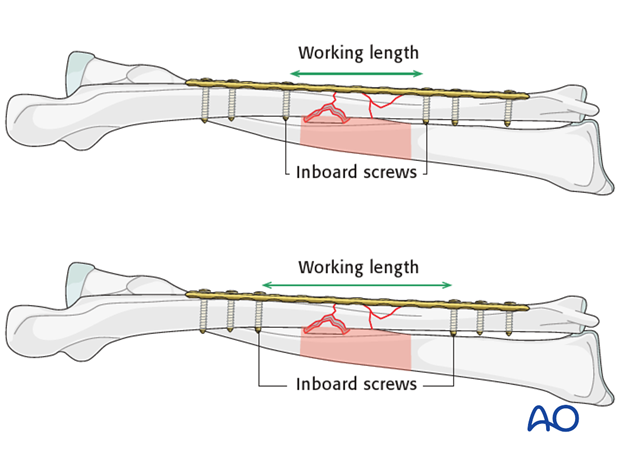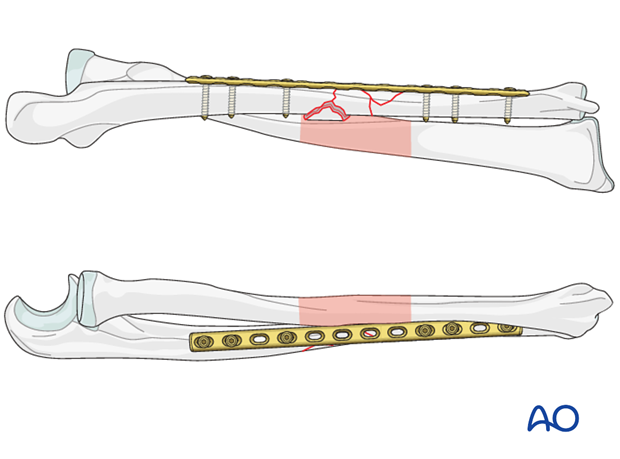Comminuted ulnar fracture: bridge plating
1. Principles
General considerations
Bridge plating uses the plate as an extramedullary splint fixed to the two main fragments while the complex fracture zone is left virtually untouched (bridged), thereby minimizing damage to the blood supply of the intermediate fragments.
Reduction of the bridged fragments will not be anatomical but the procedure is based on the restoration of the relationship of the two main fragments in terms of length, rotation and axis. In these cases, x-rays of the uninjured contralateral forearm, including both wrist and elbow, are useful as a template for restoring length and rotation.
Soft tissues should be handled with meticulous attention to the vascularity of the fracture zone.
If the ulnar bridge plating is part of the management of fractures of both forearm bones, particularly in open injuries, a single approach to both bones should be avoided if possible since excessive additional stripping would be necessary. This can lead to an increased risk of infection, nonunion, and heterotopic bone formation.
Choice of implant
The requirements for internal fixation of fragmentary segmental fractures include:
- The plate should be long enough to span the comminuted zone, and to provide at least a four-hole segment over each main fragment, giving the possibility for at least three bicortical screws in each main fragment.
- Well-spaced screws to distribute the stresses on the bone-implant composite for each main fragment
- For ulnar fractures, other than those with a very short main fragment, the limited contact dynamic compression plate (LC-DCP) is the preferred implant.
- In osteoporotic patients, or with a very short terminal segment, an angular stable plate is an option for the ulna, in which case at least one of the two screws on each side of the fracture needs to be a locking screw. The disadvantage of the locked internal fixators is that such plates are difficult to contour.

Extent of surgical approach (dissection)
Despite the long skin incision, minimal dissection should be performed in the fracture zone.

Soft-tissue considerations in comminuted zone
Avoid the placement of instruments, retractors, bone clamps, or fingers around the comminuted zone.

2. Plate position, length and number of screws
Optimal plate position – general considerations
Choose the surface of the bone which is the least comminuted. It is essential, especially in high energy fracture patterns, that adequate soft-tissue coverage be available.

In many cases, soft-tissue coverage and comminution patterns will dictate plate position, rather than biomechanical considerations.
The selection of the optimal plate position will influence the approach chosen.
Avoid any additional injury to the soft tissue over the multifragmentary zone. In addition to preserving the vascularity of the fracture zone, containment of the intermediate fragments within their soft-tissue envelope will also aid their reduction.
Plate position on ulna
To minimize interference with the soft-tissue envelope in the multifragmentary zone, the approach goes between the extensor and flexor muscle compartments and avoids stripping of the dorsal and volar aspects of the bone. A convenient location for the plate is on the dorsal aspect of the bone, but if hardware prominence is a likely problem, slight adjustment of position is acceptable. This will also permit better soft-tissue coverage of the hardware by one of the muscles.
The plate on the ulna can be positioned either under the extensor carpi ulnaris muscle (A), under the flexor carpi ulnaris muscle (B), or in the interval between them (C).
In the following procedure, we demonstrate the plate positioned deep to the extensor carpi ulnaris muscle (A).

Plate length and number of screws
In the forearm, three bicortical screws are required in each main fracture fragment due to the high torsional stresses. For biological reasons, not every plate hole should be occupied by a screw. Therefore, plates that offer at least 4 holes over each main fragment should be used.

Working length considerations
Too great a working length increases the interfragmentary motion and can result in excessive callus formation which is undesirable in the forearm as it may compromise range of rotational motion.
Too short a working length increases the stresses on that portion of the plate and can risk implant fatigue.
In bridge plating, the working length of the segment of the plate spanning the multifragmentary zone can be reduced by placing, the “inboard” screws in each main fragment as near to the intermediate segment as possible. On the other hand, greater separation of the inboard screws increases the working length.

3. Reduction and preliminary fixation of the ulna
Reduction
In general, a simpler radial fracture will have been fixed preliminarily before approaching the ulna.
The aim of reduction is to restore normal length, axis, and rotational alignment. Several techniques are available to assist in achieving the best possible reduction. Since the ulna is a straight bone, usually simple maneuvers are sufficient, such as:
- Manual traction and applying clamps onto the main fracture fragments with the aid of a plate
- Temporary external fixation, or a small distractor
- Reduction by help of the plate and distraction using a laminar spreader and an independent screw (push-pull technique)
Manual traction and applying clamps onto the main fracture fragments with the aid of a plate
As dissection avoids the comminuted zone, bone clamps can safely be applied to the main fragments avoiding the fracture zone. Manual traction is then applied. Use the plate as a template for reduction while alternately applying traction and clamping, until reduction has been achieved.


At that time, fine tuning of the reduction can still be achieved. Once reduction is completely satisfactory (clinically and radiographically), a second screw is inserted into each main fragment.
The forceps can now be removed.

Temporary external fixator or small distractor
A single tube external fixation may be sufficient to achieve distraction of the straight ulnar bone. Alternatively, a small distractor can be used.
Insert one 3 or 4 mm threaded pins into the ulnar ridge of each main fragment, in the same plane, and connect them with a single bar (preferably radiolucent). Make sure to place them so that they will not compromise later plate placement.
Distract the main fragments and when correct length and rotation have been restored, tighten the clamps.


At that time, fine tuning of the reduction can still be achieved. Once reduction is completely satisfactory (clinically and radiographically), a second screw is inserted into one main fragment, the fixator bar is loosened and a second screw is inserted into the other main fragment.
The threaded pins are now removed.

Reduction using the plate and distraction with a laminar spreader against an independent screw (push-pull technique)
Attach the plate to one main fracture fragment with either two screws or one screw plus a bone forceps. Insert an independent screw into the other main fragment a short distance (1.5 – 2 cm) beyond the end of the plate.
A loosely applied bone forceps maintains the alignment of the plate and the mobile main fragment.
Check that rotational alignment is correct.

A second, loosely applied forceps may augment the maintenance of plate/fragment alignment.

Use a laminar spreader between the independent screw and the end of the plate in order to distract the fracture, restoring length and axial alignment. The articulated tension device in distraction mode is an alternative to the laminar spreader.


One of the forceps is removed and the reduction is fine tuned as necessary. Once the reduction is completely satisfactory (clinically and radiographically), a second screw is added through the plate into the same main fragment. The laminar spreader, the remaining forceps and the independent screw can now be removed.

4. Definitive fixation of both bones
Assessment of overall forearm reduction
Before finally committing to a definitive fixation make the following checks:
- Gently examine the range of forearm rotation.
- Use image intensification 1) to check plate length and position, and 2) at each end of the forearm, to check the radioulnar relationships compared to the preoperative x-rays of the uninjured side.
Now complete the ulnar fixation by inserting additional screws as necessary.At least three bicortical screws should be inserted into each ulnar main fragment.

5. Final check of osteosynthesis
Check the completed osteosynthesis by image intensification. Make sure that the plates are at proper locations, the screws are of appropriate length and a desired reduction was achieved.
Again, check the range of motion in all directions. Because of the difficulty of perfect anatomical restoration of these complex fractures, it is advisable to check the congruity of the DRUJ radiographically by comparing it to the preoperative x-ray of the contralateral side. If residual displacement is revealed, the difficult decision then has to be made whether to attempt to revise the reductions and fixations, or to accept some residual DRUJ displacement.

6. Assessment of Distal Radioulnar Joint (DRUJ)
Before starting the operation the uninjured side should be tested as a reference for the injured side.
After fixation, the distal radioulnar joint should be assessed for forearm rotation, as well as for stability. The forearm should be rotated completely to make certain there is no anatomical block.
Method 1
The elbow is flexed 90° on the arm table and displacement in dorsal palmar direction is tested in a neutral rotation of the forearm with the wrist in neutral position.
This is repeated with the wrist in radial deviation, which stabilizes the DRUJ, if the ulnar collateral complex (TFCC) is not disrupted.

This is repeated with the wrist in full supination and full pronation.

Method 2
In order to test the stability of the distal radioulnar joint, the ulna is compressed against the radius...

...while the forearm is passively put through full supination...

...and pronation.
If there is a palpable “clunk”, then instability of the distal radioulnar joint should be considered. This would be an indication for internal fixation of an ulnar styloid fracture at its base. If the fracture is at the tip of the ulnar styloid consider TFCC stabilization.

7. Wound closure
Subcutaneous tissue and skin should be closed by interrupted sutures. In certain instances, for example with marked forearm swelling, one of the wounds may have to be left open (usually the radial approach, as the ulna is subcutaneous). There are different techniques to overcome these difficulties (e.g., elastic closure, vacuum-assisted closure, petroleum jelly gauze, skin substitute, etc.)














